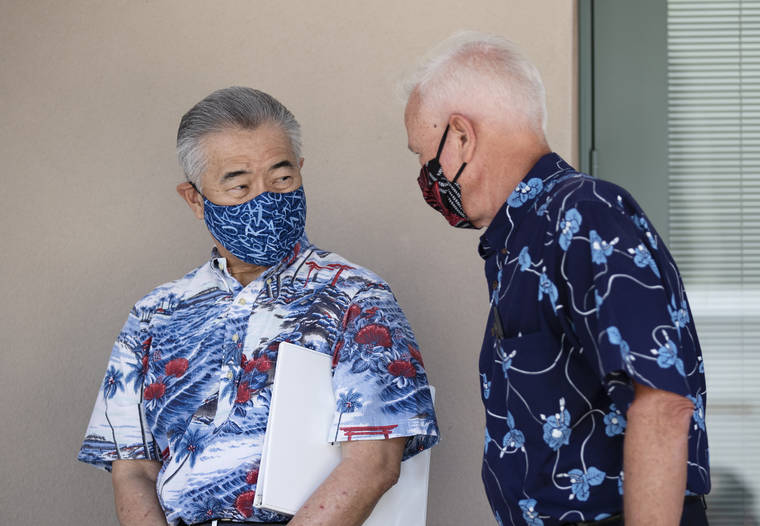Hundreds of virus contact tracers to be hired on Oahu

CINDY ELLEN RUSSELL / CRUSSELL@STARADVERTISER.COM
Gov. David Ige and Mayor Kirk Caldwell spoke to each other during a press conference on Tuesday.
Honolulu Mayor Kirk Caldwell said Tuesday the city plans to hire between 250 and 500 coronavirus contact tracers to work in coordination with the state on a “more aggressive” approach to tracking the path of the virus.
The decision represents a major city foray into coronavirus prevention after it asked for months to help but was rebuffed by the state.
It also points to a ramping up of the increased contact tracing effort that had been sought by Lt. Gov. Josh Green.
State Health Director Bruce Anderson said last Wednesday that contact tracing is one part of COVID-19 containment, but it isn’t very effective when case counts are soaring.
The collective mindset seems to be changing.
In announcing a federally- funded two-week period of Oahu “surge testing” with 60,000 available tests, Caldwell on Tuesday Opens in a new tab was flanked by U.S. Surgeon General Dr. Jerome Adams, representing new involvement by the federal government.
Don't miss out on what's happening!
Stay in touch with breaking news, as it happens, conveniently in your email inbox. It's FREE!
The new testing and contact tracing initiatives were revealed in conjunction with a new “stay at home, work at home” order.
Caldwell said about a week ago his office “got a call from the White House saying, how can we help in Honolulu? And we said we need help with testing and we we need help with tracing.”
At Tuesday’s news conference, Caldwell also noted the need for more of the experimental antiviral drug remdesivir.
Federal coronavirus officials “stood up and they responded, and the surgeon general is not up here in our community (regularly),” Caldwell said, adding Adams is “committed to Oahu for the next couple of days to help us.”
Surge testing is No. 1 in the plan to battle rising COVID-19 on Oahu, Caldwell said. No. 2 is more contact tracing “so we know where the virus is (and) we know what we need to do when we find positives.”
The third leg of the stool is quarantine, he said.
“When you find those positives,” the mayor said, “they cannot be quarantined with other members of their family who continue to go to work and spread the virus — particularly in our Pacific Islander community and in our Filipino American community where we see an increasing number of cases.”
Caldwell spokesman Alexander Zannes said the White House coronavirus task force “noticed that cases were surging (on Oahu) and reached out to see if they could help.”
The 250 to 500 new contact tracers would be in addition to those working for the state at the Hawai‘i Convention Center, Zannes said.
Emily Roberson, hired July 16 to take on the Health Department’s Disease Investigation Branch, including its contact tracing program, said last week there were 126 contact tracers on the job and another 13 support staff.
Green and others have called for between about 420 and 560 contact tracers for Hawaii.
“We want to make sure that we’re doing better on testing and notifying those who test both negative and positive that we contact trace,” Caldwell said.
By the end of July a University of Hawaii and Health Department partnership had trained 450 potential tracers. Anderson said earlier this month that most were on standby for when they were needed.
Zannes said “we’re working on” the hiring of the additional contact tracers and where they would come from with the UH pool “one of the options.”
Honolulu City Councilman Joey Manahan blasted the state COVID-19 response, saying early on, an effort was made to get testing in community health centers.
“But, you know, state government’s decision not to test and trace while the curve (was) flat now is stressing our health systems and the economy,” he said.
The Health Department “tied the city’s hands when we offered to test communities on the front lines of the pandemic back in April,” Manahan said.
That said, Manahan said he’s glad “the federal government and county are stepping in” to provide more “social justice” in the testing and tracing programs.
Gov. David Ige, who also spoke at the news conference, said his decisions have always been “data driven, looking at what’s at the best interests of our community.”
The actions taken have “flattened the curve a little.” But he and the mayor “both agree that we need to do more. We appreciate federal government support.”
Adams, the surgeon general, said Oahu is at a turning point with COVID-19 and it’s important to conduct the “temporary reset” with greater testing, contact tracing, quarantine and isolation. Positivity rates are “green” with less than 5%, “yellow” between 5-10% and “red” with greater than 10%.
“Yellow is where Hawaii is right now. Caution,” Adams said. “… That means that things could get really bad and you could go to red really quickly, or they could get much improved really quickly as people do the right things.”




